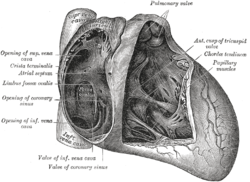- Crista terminalis
-
Crista terminalis 
Interior of the heart, frontal view. (Crista terminalis labeled at left, second from the top.) Latin crista terminalis atrii dextri Gray's subject #135 509 The Crista Terminalis represents the junction between the sinus venosus and the heart in the developing embryo. In the development of the human heart, the right horn and transverse portion of the sinus venosus ultimately become incorporated with and form a part of the adult right atrium. The line of union between the right atrium and the right auricle is present on the interior of the atrium in the form of a vertical crest, known as the crista terminalis of His (Wilhelm His, Jr.). The crista terminalis is generally a smooth-surfaced, thick portion of heart muscle in a crescent shape at the opening into the right auricle. On the external aspect of the right atrium, corresponding to the crista terminalis is the sulcus terminalis. The Crista Terminalis provides the origin for the pectinate muscles.
See also
External links
- 93978682 at GPnotebook
- SUNY Labs 20:13-0106 - "Heart: Chamber of Right Atrium"
- Atlas of anatomy at UMich ht_rt_atrium - "Right atrium, internal structure, anterior view"
- Diagram at ctsnet.org
This article was originally based on an entry from a public domain edition of Gray's Anatomy. As such, some of the information contained within it may be outdated.
Categories:- Heart
- Cardiovascular system stubs
Wikimedia Foundation. 2010.
